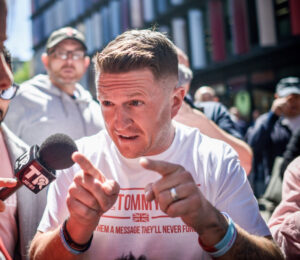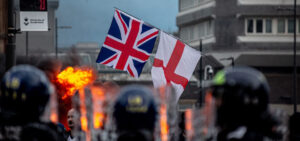Since the first spark was lit in Southport, condemnation of the rioters has largely centred on their identity as “far-Right thugs”. Indeed, some experts, including the former head of British counter-terrorism policing, have gone as far as to call the rioters terrorists. The headlines wrote themselves. For an outraged-fuelled media, Christmas had come early.
Yet dig a little deeper and things become a tad more nuanced. For all the caustic characterisations thrown the rioters’ way, their motives were far more complex and varied.
Thus far, police have made more than 1,000 arrests connected to the riots. More than 40 people have already been sentenced and that number is likely to rise markedly in the coming weeks. Already, however, what is striking about this group is their heterogeneity. Among the not so usual suspects: a 43-year-old woman who pushed a wheelie bin at police; a 34-year-old homeless mother-of-five who contrived to do the same, but instead ended up face-planting at the feet of her intended target; a 25-year-old homeless man; an 18-year-old with ADHD, a 15-year-old girl and a 15-year-old boy; a bingo-playing gay couple; and a 69-year-old retired welder.
The nature and seriousness of the violence of the rioters seems to vary greatly too, ranging from vandalism on cars to punching a police officer in the face. While the worst of the violence was very grave indeed — a library was torched and sacked in Liverpool, and there were attempts to set fire to hotels housing asylum seekers — some was more ridiculous than properly lethal: one teenager, aged 19, lobbed an egg at the police while chanting in support of Tommy Robinson.
Yet while there doesn’t seem to be a single profile of a rioter, three profiles have emerged — profiles that, ultimately, we need to distinguish if we’re to understand why these riots took place. Based on trial information and extensive online footage of the riots, they are: Combatants, Geezers and Scallies, and Losers.
The first group — Combatants — refers to the kind of rioter that many have in mind when invoking the image of the far-Right thug: namely, inveterate racists alongside self-proclaimed patriots motivated by fears about white replacement and hostility to the British state and police for their perceived collusion in this. Combatants are almost exclusively men who see themselves as defenders not only of English culture, but as the protectors of English women and girls — from, in their eyes, the rapacious sexual desires of non-white, and especially Muslim, immigrant men.
Despite this relatively strict categorisation, what remains unclear is how many Combatants were involved in the riots, how much of the violence they were responsible for, and whether that violence had been planned in advance. Nor do we know whether they were members or affiliates of organised far-Right groups or looser networks of ex-EDL activists and hooligans, like 28-year-old Liam Ryan who assaulted a black man during unrest in Manchester city centre and was already subject to a football banning order.
The second group — Geezers and Scallies — refers to older and younger men respectively with criminal backgrounds whose participation in the riots was motivated not by any considered ideological grievances, but an abiding interest in manufacturing mayhem and the drama of violent contention. Historically, riots have always attracted this kind of dissolute stress-seeker, because they present ripe opportunities for a tremendous tear-up, including hand-to-hand combat with reviled authorities and the ritualised looting of goods that are later invariably discarded or destroyed.
Unlike the violence of Combatants, there is no instrumental logic to the violence of Geezers and Scallies: it is done and enjoyed for its own sake, because it’s thrilling and existentially satisfying. At the same time, this doesn’t mean that the violence is senseless; indeed, during much of the past fortnight’s disorder, it’s hard to miss the blatant defiance, spite and mockery on show towards the police. One rioter, for example, prior to having a brick thrown at his groin, danced effeminately in front of riot police, an act of mockery that was captured in camera-phone footage that swiftly went viral.
The final group — Losers — refers to that type of rioter, both male and female, whose participation in the riots was spontaneous and situational. Many of these accidental rioters were drunk when they entered the fray, either because they’re alcoholics or had been out on a bender or both; one 30-year-old rioter who hurled metal sheeting at police in Hartlepool had reportedly drank 30 cans of larger and had no memory of his involvement in the disorder. For some, it was the first time they had been in serious trouble with the police before, unlike the other two categories of rioters, many of whom have extensive rap-sheets.
It isn’t fully clear why the roughly dozen Losers sentenced so far participated in the violence, and none can coherently explain it, other than that something in the spectacle of violence beckoned them to enter it and join in the communal revelry of semi-authorised transgression. This is something most now deeply regret and not a few have sought to distance themselves from the ideological convictions of the Combatants they were rioting alongside. For example, Kieron Gatenby, whose sentence of 16 months in prison for lobbing an egg at police in Hartlepool seems especially harsh, did not harbour any racist views, according to a probation report. “He says he is disgusted at being involved with people who were chanting racist slurs,” Gatenby’s solicitor told Teesside Crown Court at his sentencing hearing. Similarly, it transpired at the hearing of Stacey Vint that her involvement in the riots in Middlesbrough was animated more by alcohol than ideology.
Of course, the overall picture may yet change. But it does seem to suggest that the narrative that the riots were wholly the handiwork of far-Right thugs is oversimplistic. Many of the rioters didn’t see themselves as part of some political resistance; they were bored and some were angry.
The other salutary effect of looking at the profiles of the rioters is that it humanises them: in those pallid and lived-in faces in the police mugshots, we see a cross section of English working-class people from mostly northern towns. We read reports of teenage boys and girls who were involved in the disturbances and perhaps wonder about their turbulent lives and “lived experience” of white privilege. We read about someone like Stacey Vint, who is homeless because she fled an abusive relationship, and perhaps feel a stab of sympathy for her — or at least some sense of injustice that she was given such a punitive sentence (20 months in prison).
By contrast, you don’t find much humane empathy towards the rioters on social media or in the liberal press, but instead contempt and loathing. This expresses itself in different ways, one of which is a blatantly classist revulsion that sees the rioters as an odious and atavistic skidmark on multicultural society. The other is a kind of elite disdain that hides its moral revulsion under the cover of alarmist concern over the “radicalisation” of white working-class people; here, ordinary aspects of white working-class culture such as piss-taking are interpreted as signs of extremism in precisely the same way that ordinary aspects of conservative Islam were once red-flagged by Right-leaning terrorism experts like Sebastian Gorka.
None of this is to say that we should be sentimental or lenient towards the rioters. But it is imperative that we avoid painting them all with the same brush — and that means doing the more painstaking work of looking closely at their profiles and motives. Those who do otherwise — whether they are the Prime Minister, a think-tanker or a grifter angling for the Government’s attention — can call the rioters far-Right thugs or even terrorists if they like. But they shouldn’t kid themselves that they’re doing anything other than playing the grubby game of politics, much less providing any understanding of why the riots unfolded, and how they could unfold again.
Disclaimer
Some of the posts we share are controversial and we do not necessarily agree with them in the whole extend. Sometimes we agree with the content or part of it but we do not agree with the narration or language. Nevertheless we find them somehow interesting, valuable and/or informative or we share them, because we strongly believe in freedom of speech, free press and journalism. We strongly encourage you to have a critical approach to all the content, do your own research and analysis to build your own opinion.
We would be glad to have your feedback.
Source: UnHerd Read the original article here: https://unherd.com/



